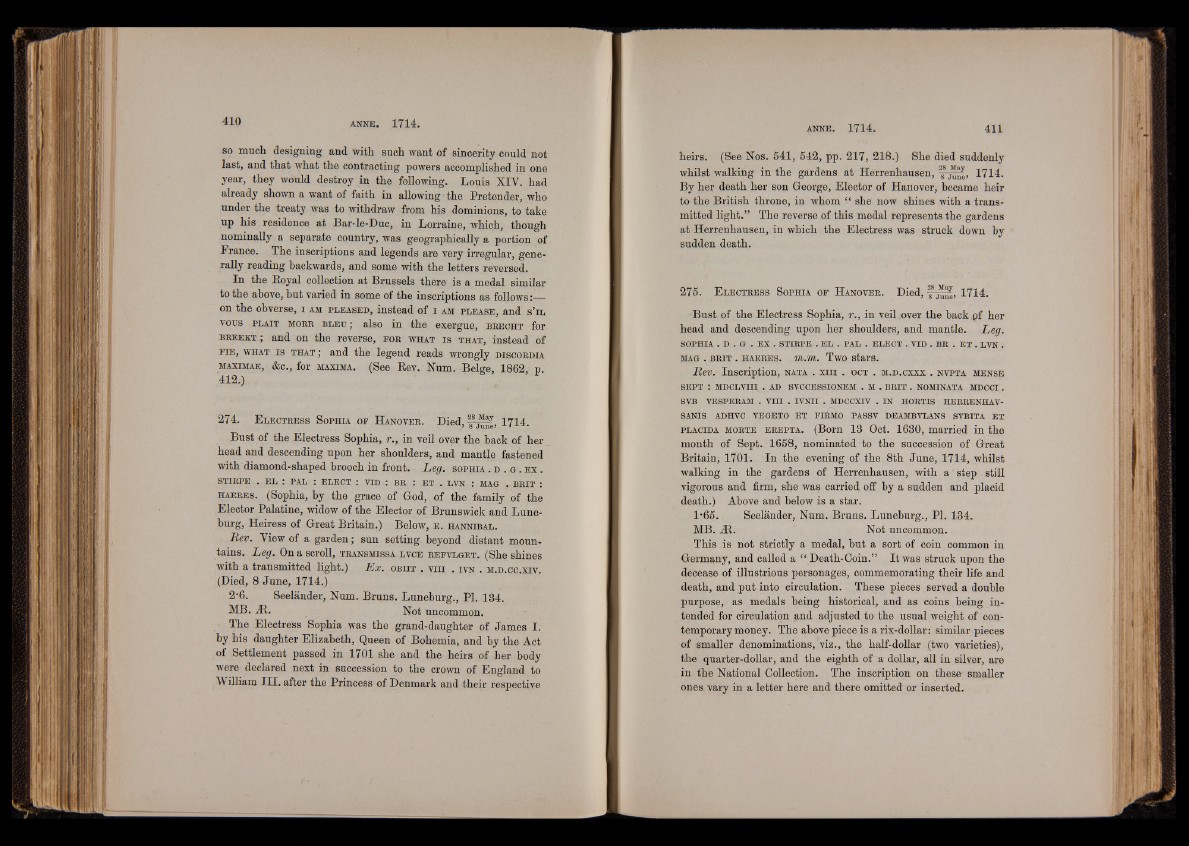
so much designing and with such want of sincerity could not
last, and that what the contracting powers accomplished in one
year, they would destroy in the following. Louis XIV. had
already shown a want of faith in allowing the Pretender, who
under the treaty was to withdraw from his dominions, to take
up his residence at Bar-le-Duc, in Lorraine, which, though
nominally a separate country, was geographically a portion of
France. The inscriptions and legends are very irregular, generally
reading backwards, and some with the letters reversed.
In the Royal collection at Brussels there is a medal «irm’lar
to the above, but varied in some of the inscriptions as follows:—
on the obverse, i am p l e a s e d , instead of i am p l e a s e , and s ’i l
vous p l a it m o r e b l e u ; also in the exergue, b r e c h t for
BREEKT; and on the reverse, f o r w h a t i s t h a t , instead of
f i e , w h a t is th a t ; and the legend reads wrongly d is c o r d ia
m ax ima e, &c., for maxima. (See Rev. Num. Beige, 1862, p.
412.)
274. E l e c t r e s s S o ph ia o f H a n o v e r . Died, 1714.
Bust of the Electress Sophia, r., in veil over the back of her
head and descending upon her shoulders, and mantle fastened
with diamond-shaped brooch in front. Leg. s o ph ia . d . g . e x .
STIRPE . EL : PAL : ELECT : VID : BE : ET . LVN : MAG . BRIT :
h a e r e s . (Sophia, by the grace of God, of the family of the
Elector Palatine, widow of the Elector of Brunswick and Lune-
burg, Heiress of Great Britain.) Below, e . h a n n ib a l .
Rev. View of a garden; sun setting beyond distant mountains.
Leg. On a scroll, t r a n sm is sa l v c e r e f v l g e t . (She shines
with a transmitted light.) Ex. o b h t . vm . iv n . m .d .c c .x iv .
(Died, 8 June, 1714.)
2-6. Seelander, Num. Bruns. Luneburg., PI. 134.
MB. At. Not uncommon.
The Electress Sophia was the grand-daughter of James I.
by bis daughter Elizabeth, Queen of Bohemia, and by the Act
of Settlement passed in 1701 she and the heirs of her body
•were declared next in succession to the crown of England to
William III. after the Princess of Denmark and their respective
heirs. (See Nos. 541, 542, pp. 217, 218.) She died suddenly
whilst walking in the gardens at Herrenhausen, 288 1714.
By her death her son George, Elector of Hanover, became heir
to the British throne, in whom “ she now shines with a transmitted
light.” The reverse of this medal represents the gardens
at Herrenhausen, in which the Electress was struck down by
sudden death.
275. E l e c t r e s s S o p h ia o f H a n o v er . Died, 1714.
Bust of the Electress Sophia, r., in veiljover the back pf her
head and descending upon her shoulders, and mantle. Leg.
SOPHIA . D . G . EX . STIRPE . EL . PAL . ELECT . VID . BR . ET . LVN .
MAG . BRIT . HAERES. Wl.TO. Two Stars.
Rev.' Inscription, nata . x i i i . o ct . m .d . cxxx . n v pta m e n s e
SEPT : MDCLVIII. . AD SVCCESSIONEM . M . BRIT . NOMINATA MDCCI.
SVB VESPERAM . VHI . IVNII . MDCCXIV . IN HORTIS HERRENHAV-
SANtS ADHVC VEGETO ET FIRMO PASSV DEAMBVLANS SVBITA ET
p l a c id a m o r t e e r e p t a . (Born 13 Oct. 1630, married in the
month of Sept. 1658, nominated to the succession of Great
Britain; 1701. In the evening of the 8th June, 1714, whilst
walking in the gardens of Herrenhausen, with a step still
vigorous and firm, she was carried off by a sudden and placid
death.) Above and below is a star.
1-65. Seelander, Num. Bruns. Luneburg., PI. 134.
MB. At. Not uncommon.
This is not strictly a medal, but a sort of coin common in
Germany, and called a “ Death-Coin.” It was struck upon the
decease of illustrious personages, commemorating their life and
death, and put into circulation. These pieces served a double
purpose, as medals being historical, and as coins being intended
for circulation and adjusted to the usual weight of contemporary
money. The above piece is a rix-dollar: similar pieces
of smaller denominations/viz., thé half-dollar (two varieties),
the quarter-dollar, and the eighth of a dollar, all in silver, are
in the National Collection. The inscription on these smaller
ones vary in a letter here and there omitted or inserted.